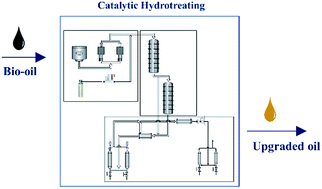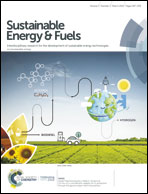Hydrotreating of Hydrofaction™ biocrude in the presence of presulfided commercial catalysts†
Abstract
The catalytic hydrotreating of biocrude, obtained from Hydrofaction™ HTL technology, was studied in a continuous fixed bed reactor. The effects of operational conditions including temperature, space velocity, pressure and H2 : oil ratio were explored in the presence of commercial presulfided CoMo and NiMo catalysts. The results from experiments using a single stage of CoMo catalyst indicated that the properties of the upgraded oil improved by increasing the hydrotreating temperature. By increasing the temperature from 320 to 370 °C at a space velocity of 0.3 h−1, the viscosity of HTL biocrude was reduced by 98% reaching 78 cP, and the total acid number reduced by 54%, reaching 6.1 mg KOH/g. Also, oxygen content decreased from 10.9 wt% in biocrude feed to 4.7 wt% and 2.2 wt% after hydrotreating at 320 and 370 °C, respectively. The results of FTIR analyses confirmed that the concentrations of oxygen functional groups, including alcohols, carboxylic acids and ketones, decreased with increasing reaction temperatures. The progress of hydrogenation and cracking reactions at higher upgrading temperatures was evident via high temperature simulated distillation and elemental analysis; the boiling point distribution of products shifted to lighter materials and the H : C ratio increased to 1.53 at a reaction temperature of 370 °C. The properties of the upgraded biocrude improved by decreasing the space velocity from 0.5 h−1 to 0.2 h−1; the TAN decreased from 8.5 to 3.7 mg KOH/g, and oxygen content decreased from 3.8 to 2.4 wt%. No significant improvement, however, was observed by increasing the H2 : oil ratio from 900 to 1300 Nm3 m−3 oil. A simulation of the phase behavior confirmed the negligible impact of H2 : oil ratio on the hydrogen solubility in the biocrude. Two stage catalytic hydrotreating experiments were studied, where the product of a first stage of hydrotreating in the presence of sulfided CoMo catalyst was further processed in a second stage using a sulfided NiMo catalyst. The results of these experiments indicated that upgrading product quality significantly improved after the second hydrotreating. After two-stage upgrading, the residue fraction (>550 °C) decreased from 35% in the feedstock to 5% in the product, and the diesel fraction increased from 27% to 52%.



 Please wait while we load your content...
Please wait while we load your content...